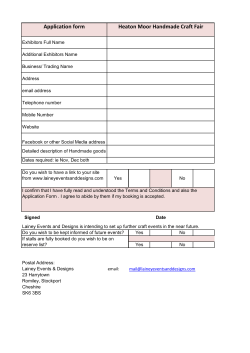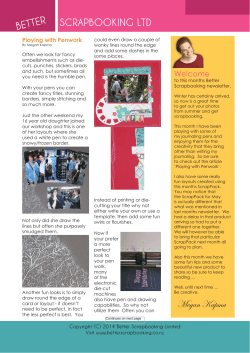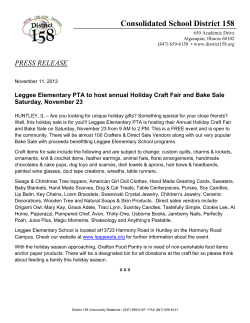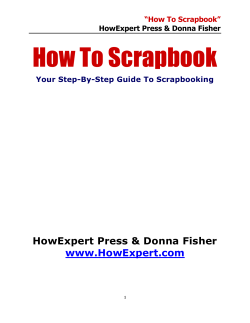
CRAFT GUIDELINES
CRAFT GUIDELINES Objective: Develop skills, abilities and creative thinking in an arts and craft area. Learn to work with a variety of techniques, color combinations and textures. Guidelines 1. Members may enter only one project per section listed in the fair book. 2. Craft projects can be made from a kit or your original design but should be reflective of your skill level. 3. Craft exhibitors may participate in Fashion Revue if their item is wearable. Contact Fashion Revue Superintendent by July 25th for approval. Definition of Classes: Beginners: First and Second Year Intermediate: Third and Fourth Year Advanced: Fifth year and up Year classifications are up to the discretion of the leader or parent. Placement should depend on the ability and advancement of the 4-H’er. Craft Index A. B. C. D. E. F. G. H. I. J. K. L. M. N. O. P. Q. R. S. T. U. V. W. Baskets: reed, cloth and paper etc. Cloth Crafts: soft sculpture, pillows etc. Creative Crafts: Bread dough art, beads, miniature rooms, silk flowers etc. Dolls: Corn husk, raffia, apple head, clothespin, soft sculpture etc. Foam Craft Holiday Crafts: represent different seasons & media. Glass Craft: stained glass, etching, leaded etc Macramé: yarn, rope etc. showing macramé skills Metal Craft: wire art, enameling, etching, hammered metal, tin punch etc. Natural Craft: basket making, woodburning, collage, decoupage etc. Paper Crafts: paper tole, origami, gift-wrap etc. Plasterware: whiteware Plastic Craft: clear cast, suncatchers etc. Puzzel Craft Recycled Craft: item made using recyclable materials. Stamp Art: cards, stationary, envelopes etc. decorated with stamps.(see guidelines at bottom of page) Stenciling: Stenciling technique used on any media. Textile Painting: all pictures must be framed or matted and ready to hang. Wax Craft: candles or other wax item dipped, molded or sculptured. Wearable Art: jewelry, t-shirts, sweatshirts etc. Wood Craft: craft items made from wood, popsicles Wreaths: all media Leathercrafts STAMP ART Stamp art is creativity on paper. Guidelines Most stamp art projects are considered a short-term project. Some may take longer to make. If your particular project is challenging and takes two hours by itself, one project is all that is required. Note: Projects should not be on clothing or material, this would require different ink. Display If cards are made they should be displayed together with their envelope. Projects should be displayed on a small placemat, foam-core board, poster board etc. With the child's name, age and 4-H project year on the back. Projects should sit only! NOT be taped or glued to your display board. Beginners: first and second year Intermediate: third and fourth year Advanced: fifth year and up These classifications are up to the leader. For example, if the child is thirteen years old and a first year 4-Her they need not be placed in the beginner's category. This placement should depend on the ability of the 4-Her. Stamp Art Requirements Beginners choose one of the following: Set of three cards, two colors of ink minimum with envelopes to match *Gift bag, tag and tissue paper project requires stamping on every piece so they match. Tag should be smaller than a card and have room for the receiver's name. Bag may be bought or made. *Cube notepad is bought and stamped neatly around sides, individual pages can be stamped as well. Small notepad must have a stamped cover, like the one shown on example page (for the small notepad fold twice, once on either side of the thick solid lines). Intermediate choose one of the following: Set of three cards, three colors of ink minimum with envelopes to match Gift set (box, tissue paper and card with envelope to match) Box, paper and card must be stamped neatly to match. (It is easiest to stamp box before it is formed.) Box may be bought or made. *Magazine file is created by cutting a cereal box on a diagonal and covering with stamped paper. A tag or identification plate may also be stamped. *Picture frames(2) are assembled by placing a photograph between two pieces of cardstock. The top piece should have a pre-cut "window" through which you may view your photograph. The frame should then be stamped or have a stamped figure attached to it securely. Advanced choose one of the following: One card with handmade envelope. Envelope template available at 4-H office. Set of three cards, made with vellum; wet embossing or raised pieces with envelopes to match *Handmade book/journal can be created by covering an already made blank book in stamped paper, stamping individual pages of a blank book or by creating your own (use two sheets of heavy card-stock for the covers and thinner card-stock for the pages. Three hole punch them and bind with metal rings or ribbon. Cover pages must be stamped). Stationary with envelopes to match. Stationary may include note cards, a pad of stamped paper and envelopes to match. All components must be stamped and have room for a letter or address where applicable. SCRAPBOOKING Guidelines for all Scrapbooks: 1. Neatness is very important. Exhibit clean pages with clear handwriting. Your handwriting is part of your heritage. Computer created writing is also allowed but most important is meaningful journaling “why this is important to you”. 2. Please spell words correctly and use a dictionary if necessary. 3. Keep in mind the proper placement of photos, etc. in your album. Your scrapbook is telling a story. Use chronology (putting things in order of occurrence) or seasonal activities to organize your scrapbook. 4. Journaling is to be used along with your photos and memorabilia. Without journaling, over time, your photos and memorabilia will become less meaningful to you and others. Meaningful journaling will improve your score. 5. Using a variety of cropping techniques and page layouts will add interest and creativity to your album. Not everything has to be cropped or ‘artsy’. Use a nice balance, keeping in mind that the main focus is preservation and not how many stickers or fancy papers you can use on a page! 6. The scrapbook album must demonstrate a good sense of the entire project and what it means to preserve our memories. Scrapbook Project Requirements Level A Grades 3-4 Exhibit one 2-page spread that includes: • Title with theme. • Cropped pictures – every picture does not have to be cropped. • At least one enhancement. Enhancement includes: stickers, die cuts, decorative paper and stamping. • Journaling – who, what when, where and most important “why” it’s important to you. • Pages may be 12” x 12” or 8 ½” x 11”. • All supplies should be acid/lignin free. Pages should be buffered as well. • The pages should be exhibited in an album with a front and back cover with pages firmly attached between the covers. • All pages must have page protectors. • All other basic requirements and exhibit rules should be met. Scrapbook Project Requirements Level B Grade 5-6 Exhibit 3 completed scrapbook pages (6 completed sides) that include: • At least one 2-page spread that has a themed title. • Cropped pictures – every picture does not have to be cropped. • At least one enhancement per page. Enhancement includes: stickers, die cuts, decorative paper and stamping. • At least one scrapbooking technique within the 6 pages. • Journaling should include labeling of photos with names, dates, places, etc., plus capturing your memories with captions or words recording the happenings of the photos. • Pages may be 12” x 12” or 8 ½” x 11”. • All supplies should be acid/lignin free. Pages should be buffered as well. • The pages should be exhibited in an album with a front and back cover with pages firmly attached between the covers. • All pages must have page protectors. • The album should contain 3 pages front and back, for a total of 6 sides. All pages should have been completed since last year’s fair. Incomplete or unfinished pages will not be counted toward your 6 side total. • Other basic requirements and exhibit rules should be met. Scrapbook Project Requirements Level C Grades 7-9 Exhibit 5 completed scrapbook pages (10 completed sides) that include: • At least two 2-page spreads that have a themed title on each double spread page. • Cropped pictures – every picture does not have to be cropped. • At least one page should contain memorabilia (postcards, brochures, program, invitation, etc.). • At least one enhancement per page. Enhancement includes: stickers, die cuts, decorative paper, rubber stamps, drawing, using pocket pages for memorabilia and ruled pages. • At least two scrapbooking techniques should be used within the 10 sides. • Journaling should include: labeling of photos with names, dates, places, etc., plus capturing your memories with captions or words recording the happenings of the photos. • Pages may be 12” x 12” or 8 1/2” x 11”. • All supplies should be acid/lignin free. Pages should be buffered as well. • The pages should be exhibited in an album with a front and back cover with pages firmly attached between the covers. • All pages must have page protectors. • The album should contain 5 pages front and back, for a total of 10 sides. All pages must have been completed since last year’s fair. Incomplete or unfinished pages will not count toward you 10 side total. • Other basic requirements and exhibit rules should be met. Scrapbook Project Requirements Level D Grades 10 and up Exhibit 8 completed scrapbook pages (16 completed sides) that include: • At least three 2-page spreads that have a themed title on each double spread page. • Cropped pictures – every picture does not have to be cropped. • At least one page should contain memorabilia (postcards, brochures, program, invitation, etc.). • At least one enhancement per page. Enhancement includes: stickers, die cuts, decorative paper, rubber stamps, drawing, using pocket pages for memorabilia and ruled pages. • At least three scrapbooking techniques should be used within the 16 sides. • Journaling should include: labeling of photos with names, dates, places, etc., plus capturing your memories with captions or words recording the happenings of the photos. • Pages may be 12” x 12” or 8 ½” x 11”. • All supplies should be acid/lignin free. Pages should be buffered as well. • The pages should be exhibited in an album with a front and back cover with pages firmly attached between the covers. • All pages must have page protectors. • The album should contain 8 pages front and back, for a total of 16 sides. All pages must have been completed sine last year’s fair. Incomplete or unfinished pages will not count toward your 16 side total. • Other basic requirements and exhibit rules should be met.
© Copyright 2025















